Category: Critical Design
PhD 90% Seminar

This week I had my 90% (“final”) seminar with Heather Wiltse from Umeå Institute of Design. I’m very appreciative of her engagement with my work and difficult questions that energized me for my next few months of writing. The tentative title and abstract of my thesis below:
Designing with care: Self-centered research for interaction design otherwise
This dissertation is about the research program designing with care as a pathway towards interaction design otherwise amid a world in crisis. Considering how established ways of doing interaction design will change involves recognizing the role of digital materials in social injustice and systemic inequality. These concerns are inseparable from the material complexity of interactive experiences and their entanglements in care. Through five design experiments, I explore wickedly attending to human everyday care, and an intimate and generous questioning of oneself.
I offer four contributions for interaction designers and design researchers. The main contribution is designing with care. Within this programmatic framework, I contribute extended articulations of wickedness and generosity. The third contribution is the synthesis of four methodological approaches: auto- design, spatial orientations, leaky materials, and open speculations. Each is a generative and analytical pathway towards five careful designs as prototypes of what interaction design otherwise might be like: technologies of human waste, spying on loved ones, leaky breastfeeding bodies, scaling bodily fluids, and a speculative ethics. From these, I discuss disciplinary resistances and personal struggles to reflect upon implicating oneself within more-than-human care, and consider the benefits and limitations of designing with care in moving beyond self-centered research towards more sustainable worlds.
PhD 50% Seminar
Last Wednesday I had my 50% PhD seminar! Sill processing the feedback from my opponent Lone Koefoed Hansen who Zoomed in from Aarhus University, but very thankful for an inspiring discussion.
A short overview of my research can be found here Careful Design: Implicit Interactions with Care, Taboo, and Humor. And an even shorter snapshot of 2.5 years in 16 seconds:

DIS 2020 – Accepted Doctoral Consortium Proposal
Having only recently returned to work full-time in March from ten months of parental leave, and despite working from home rather than in the lab due to COVID-19, it has felt wonderful to re-engage with my research with new energy and focus. Even more rewarding was to recently find out that my Doctoral Consortium proposal was accepted to DIS 2020. Very much looking forward to discussing my work with the Chairs and other participants – even if most likely virtual! Below is my title, abstract, and a link to the pre-print.
DIS 2019 – Presentation and Slides
Today my paper Do you have to pee? A Design Space for Intimate and Somatic Data will be presented at DIS 2019 in San Diego by a colleague from KTH as I am currently on parental leave with my four week old daughter. Would love to be at the conference presenting and discussing this work, but am more grateful for the conference’s flexibility and Vasiliki Tsaknaki’s assistance in the presentation of this paper while I am instead home in Sweden!
Since this research includes an autobiographic approach and a reflection on my positionality as a design researcher, both of which are critical to the work, the presentation I prepared included both video and audio recording of myself intermixed among a script for Vasiliki (which is why the script includes a mix of first and third person). It was definitely a new challenge rethinking how to make a presentation that included my own voice while using my colleague’s presence for audience engagement! Below is the full written script and slides, and the full paper (which won an honorable mention award!) is available here.

DIS 2019 – Accepted Paper
Couldn’t be more please to find out today that I have a full paper accepted to DIS 2019! Very thankful for my amazing colleagues who provided invaluable support for and feedback on the paper.
Below is the title and abstract, will post a camera ready version in the coming weeks.

Do you have to pee? A Design Space for Intimate and Somatic Data
The management of bodily excretion is an everyday biological function necessary for our physiological and psychological well-being. In this paper, I investigate interaction design opportunities for and implications of leveraging intimate and somatic data to manage urination. This is done by detailing a design space that includes (1) a critique of market exemplars, (2) three conceptual design provocations, and (3) autobiographical data-gathering and labeling from excretion routines. To conclude, considerations within the labeling of somatic data, the actuating of bodily experiences, and the scaling of intimate interactions are contributed for designers who develop data-driven technology for intimate and somatic settings.
KTH 2018 PhD Supervisory Panel
Today was our department’s annual PhD Supervisory Panel at KTH during which PhD students are given the opportunity to get feedback from senior researchers who act as “guest supervisors.” To prepare for my meeting with two Associate Professors I reworked my research abstract and research questions following my 30% seminar in October, during which Johan Redström from Umeå Institute of Design acted as my discussant. My goals in today’s supervisory panel were to get feedback on the new scope of my abstract and research questions relative to being only about 40% through my PhD (and I’m sure will continue to evolve), and identify important areas that I need to work on articulating to more firmly position my research in the context of how I am conceptually “furnishing” my design space. Considering I was presenting to senior researchers from different academic backgrounds than my own and each other, it was especially helpful to see within which aspect I felt misunderstood, i.e. where I need to sharpen my arguments. Below my poster summarizing my research thus far, followed by a few notes/reflections based on feedback received today, and a textual version of my abstract and research questions.

UID Wednesday Lecture 2018 – Crafting Humorous Fictions & Taboo Frictions
Yesterday I had the pleasure of spending the day at Umeå Institute of Design (where I did my MFA in Interaction Design). In the morning I spent a couple hours with upcoming IxD master thesis students to discuss my experience, and in the afternoon gave a talk titled “Crafting Humorous Fictions & Taboo Frictions” as part of the design school’s Wednesday lecture serious. Was great to be back, even if only for a day! Below is the abstract of my talk.

Talk abstract
Karey Helms is a PhD Student at KTH Royal Institute of Technology researching smart implicit interactions, those that are unseen or unnoticed yet proactively operate on our behalf. Her research through design approach includes speculative and autobiographical methods in which she designs humorous fictions and taboo frictions with intimate and somatic data to surface the social and societal implications of data-driven systems. These include the designing of fictional devices that predict when and how badly one has to urinate, and the prototyping of a genuine system to spy on her partner.
In this talk, she traces back her playful approach to fiction and friction to her master’s thesis in Interaction Design at UID and how she employed this approach while working in industry delivering actualized services within enterprise IoT prior to beginning her PhD. The aim of this talk is to advocate for humor in design and to craft experiences that disrupt and disturb to not only provoke others to think, but also yourself as a designer.
Design Briefs – Spying on Loved Ones & Tangible Designs for Effort, Exertion, and Exhaustion
For this year’s Advanced Project Course in Interaction Design at KTH, I’m fortunate and excited to have two groups of second-year master’s students working with me on two project briefs – Spying on Loved Ones and Tangible Designs for Effort, Exertion, and Exhaustion during Outdoor Experiences. Excited to see their resulting design work in December!
Spying on Loved Ones
To spy on someone is commonly thought of as a negative or harmful act during which one person secretly observes or collects information on another for malicious purposes. Yet, we also “spy” for many positive reasons. For example, these might include watching a sleeping child through a baby monitor, checking a partner’s calendar to plan a surprise birthday party, or browsing the fridge of an elderly parent to ensure a healthy diet is being consumed. What these examples have in common is that they are acts of care. This projects investigates how we care for others through technology, both with technologies explicitly designed to survey or observe others and through technologies designed for other purposes yet leak implicit information that enables spying. Within this investigation, various forms of spying will be classified and critiqued, the social and cultural implications of these positive intentions with be explored, and speculative prototypes will be designed to either further enable or inhibit spying.
The project will follow the suggested steps: (1) a review and critique of technologies explicitly designed for spying in private and public spaces, (2) investigation into ways in which people spy on others through technologies not designed for spying, possibly through workshops, interviews, or cultural probes, (3) the design of speculative prototypes to either further enable or inhibit spying, resulting in an ecology of physical artifacts. Required skills include strong design sensibilities and an interest in critical design and design fiction.
This project builds upon Leaky Objects: Implicit Information, Unintentional Communication.
Tangible Designs for Effort, Exertion, and Exhaustion during Outdoor Experiences
Multi-day outdoor activities such as hiking, skiing, cycling, and horseback riding involve full body engagement, during which bodies become sore and often endure physical transformations. Yet despite perceived discomfort and difficulties, outdoors experiences are often considered rewarding and relaxing. Thus, rather than designing to make these activities easier or more comfortable, this project investigates designing tangible artifacts and devices to celebrate or enhance these experiences of effort, exertion, and exhaustion. This project is part of a broader, ongoing outdoors project within the Smart Implicit Interaction project, and has the opportunity to build upon recent interviews with participants who have engaged in long-term outdoors experiences.
The outcome of the project is open-ended, but students are expected to engage in a design process to that result in novel artifacts that are either proposed objects of use (e.g. products) or result in interesting new learnings (e.g. cultural probes). Students should have a design background or be interested in following a design process.
NordiCHI 2018 – Accepted Paper (Future Scenarios)
Very excited to have a NordiCHI 2018 paper accepted in the future scenarios track! Written with Ylva Fernaues, my supervisor at KTH, the paper is about why and how I used humor in my MFA thesis at Umeå Institute of Design four years ago.
Karey Helms, Ylva Fernaeus. 2018. Humor in Design Fiction to Suspend Disbelief and Belief. ACM Nordic Conference on Human-Computer Interaction (NordiCHI 2018), Oslo, Norway.

Humor in Design Fiction to Suspend Disbelief and Belief
This paper investigates humor as a resource and strategy for design with discourse as an intended outcome. While humor can incite empathy and understanding, it can also lead to alienation and disengagement. Through the detailing of the pre-narrative and narrative processes of an exemplar design fiction we describe why and how elements of humor, in particular puns, parody, and pastiche, were employed. Following the presentation of the fiction and its use in the design of an exhibition and diegetic prototypes, the paper presents responses from participants and audience members to reflect upon how humor was received within the design fiction. Following these reflections, as the near-future scenario was written four years prior to this paper and is now situated within present-day, it then concludes with a post-mortem reflection on the floating nature of humor.
DIS 2017 – Workshop Reflections and Design Fiction
As previously mentioned, I attended, and thoroughly enjoyed, the workshop at DIS17 on People, Personal Data and the Built Environment. Not only was the topic relevant to my project, interests, and background, but I also found the strict structure (and quick introductions) very effective and thus resulting in meaningful discussions at the end of the day.
The below image is a fraction of a future IoT system followed by a corresponding fictional narrative created with Albrecht Kurze.

Unfinished Business
2022 – five years after 2017 – a public space odyssey
It is the year 2022, five years after the government started to implement the dynamic waiting management system in public buildings. To simultaneously reduce waiting times while keeping visitors preoccupied, the system routes visitors on an adaptive, and often the least efficient, way through the building. As this has unsurprisingly resulted in many lost visitors, a place-based location-aware voice-controlled guiding and help-and-get-helped system was introduced, in which visitors can leave voice messages to aid other lost visitors.
Dave was born in 1950 and retired in 2017, the same year his wife died. Every time he enters public buildings, he is asked to confirm the usage and data processing terms of the building, as smart building are being classified as interactive data processing units by the 2019 extended GDPR. These temporary consents are based on minimum viable data and are thus only valid for a single visit as all data collected is automatically deleted or anonymized upon leaving.
Dave pretends to apply for a hunting license but actually just wants to hear his wife’s voice in a message she left in the help-and-get-helped system after the system’s implementation. As the system is gender intelligent, he needs a female to find his wife’s message. Furthermore, the message is not locationally linked nor directly addressable because of dynamic shuffling and the anonymization policy.
Claire was born in 2001 and has been applying for a family planning permit for the past five days. As the system is implicitly regulating family planning, prioritizing lonely widows and widowers for which Claire is not, it sends her on an impossible route. As she is not successful in her quest for a permit by the end of each day, the temporary data consent causes her to restart the whole process the following day, resulting in a never ending journey.
But this one special day Dave and Claire met, two lost visitors, trapped some way in and by the system. They decided to help each other and resolve their unfinished business.
Workshop – The Cultures of Machine Participation
Earlier this week I attended a workshop held by the research group for the design of information systems (DESIGN) at the University of Oslo (UiO) on The Cultures of Machine Participation.

Interact 2016 – Insights in Self-centred Design
This week I spoke at Interact 2016 – slides and script below – a rather intimidating lineup alongside digital and physical architects whom all I greatly admire. I’m very grateful to Nomensa for the opportunity – not only is every talk an immense learning opportunity in public speaking, but I value even more the work prior – for the rigorous synthesis and curation of empirical insights is a process all designers should engage within as a practice of communication and reflection. Enjoy!
WIAD16 Bristol – Making the Invisible Physical
Below is the loose script and slides from a 20 minute talk I gave in Bristol for World IA Day 2016 – “Information Everywhere, Architects Everywhere.” I presented personal design projects in which I prototype physical manifestations of invisible interactions from the mundane moments of my daily life, and the resulting insights that inform how I make sense of complex sociotechnical systems and dynamic information exchanges to design meaningful enterprise solutions. More information on the event and other speakers in Brisol can be viewed on the Lanyrd event page.
MFA Thesis – UID Exhibition at Semcon
I was selected to exhibited and present my Interaction Design thesis project, The Family Circuit: A New Narrative of American Domesticity, with a group of other UID graduates for three days at Semcon in Göteborg, Sweden.

MFA Thesis – The Family Circuit report
First draft of my MFA thesis report has been ordered from blurb. PDF version available to download here.

Thesis Gateway Presentation Feedback
Following my gateway presentation last Friday, I received a lot of helpful feedback regarding my next steps and exhibition priorities and setup. During my presentation I skipped all previous background and process material and essentially launched into a narrative of the fictional world and characters I’ve created – you can read the first draft iteration of The Family Circuit: A New Narrative in American Domesticity.

Feedback from reviewers included:
- Finding a balance between conveying main message quickly vs requiring in depth analysis. Is the goal to get the message quickly? Essentially, my exhibition needs to be able to cater to those with a short attention span, while also allowing the various layers of the project and story to reveal over more time and with additional material. I personally am more inclined to cater to the latter, as I feel making the message overly explicit will sacrifice the experience of peeling back the layers.
- Emphasis on storytelling: be sure to connect and relate the characteristics of the characters into and through the cycles of daily events (something I have but need to work on making more explicit and central).
- 5 minute presentation at design talks could be a a narrative describing the world and omitting the why/how I got here. Of course, followed by an ‘if you want to see more, check out my exhibition…’
- Make the exhibition minimal, highlighting the artifacts. Hint at other aspects of family life, but don’t overload with unnecessary details.
- START STAGING NOW. Make a mini mockup of the exhibition plan, which could also inform if I want to make it full scale (most likely) or something along the lines of a cornell box.
- Various supplementary ideas: Pulp fiction book, digital photo frame, Whole Earth Catalog (love love!), mockumentary (Modern Family & The Office – REALLY which I had time for this, but unsure)
- Make my infomercial idea a higher priority
- Make objects in photos/GIFs/video pop in relation to Energy of Things catalog
- Match the exhibition setting to the scenes used in supplementary material
- Don’t forget to relate and check back to my original intention: energy consumption awareness
My own thoughts & reflections:
- Lots to do!
- Keep having fun!
The Family Circuit: A New Narrative of American Domesticity
Last Friday was IxD thesis gateway presentations – more so a private discussion with tutors and reviewers to assess our thesis progress, plans, and priorities for the upcoming five weeks. As my thesis is taking a strong design fiction direction, I did not give a presentation, yet read my draft narrative. To be completed this week, but please enjoy the preview below… it’s proudly quite ‘punny’ (wink wink).

The Family Circuit: A New Narrative of American Domesticity
It was a cloudy morning in early May, as were most days in Newtown. Otto Power approached the front door to check the weather, only to encounter resistance. Annoyed at the door’s conduct (tivity), he countered the friction with force, and it hesitantly opened – subtly challenging his potential motive while also directly insinuating the impending consequence. Going outside before breakfast was a break in Otto’s usual morning routine, especially for a weekday, and the mental energy used by the intelligent door to evaluate the uncommon situation would cost him the required electricity for a warm cup of coffee. Otto already speculated as much, for it was rare to have a morning electrical surplus. But he had woken with a vague yet irrepressible weight growing in his body, for Otto Power was tired. And so the forthcoming electricity sacrifice failed to impede the growing hope of a different day, and as he stepped outside he thoughtfully wondered aloud, “Will it be windy today?”
Family Circuit – Project Name & Inspiration
FINALLY got around to naming my thesis project due to some much needed pressure as all graduating students were asked to submit a selection of project information for the UID’14 Design Talks upcoming webpage. After a serious brainstorm yesterday morning, I came up with ‘Family Circuit,’ a subtle play and similarity to ‘Family Circus’ as recent developments in my project have brought forward the the family dynamics, individual characters, daily energy rituals, and cohesive storyline as a central focus of both my ideation and final deliverables. Which, on that note, also brings to light that though prioritized highly in my original goals, I’ve come to the realization that working energy harvesting prototypes are not essential to communicate my concept, and thus will take a back seat if explored at all. On the fun side, I’ve very much enjoyed this week researching and watching films featuring dysfunctional families – Wes Anderson perhaps being most influential. Great Wes Anderson Montage below by Alejandro Prullansky:
Though, its quite hard to top my favorite film family of all time – the Hoover family from Little Miss Sunshine.

Thesis Mid Review Feedback
I am very pleased with last week’s thesis mid review presentation and feedback. While I typically don’t look forward to ‘the making of’ – presentation process days – I’ve found these frequent thesis presentations useful both personally to more strongly formulate the best way of delivering my work, as well as extremely fruitful for the class to reconnect regarding each others projects. Not to mention, its exciting and rewarding to formally see your own progress. You can also view/read my full mid review presentation.

Feedback from reviewers included:
- One unified story in the end, perhaps focusing on a specific daily cycle within a single day of the year
- Videos as a potential result or strong support material
- Return to earlier ideas and re-brainstorm around them
- Potential organization of scenarios around maintenance (ex: father must take something to work to continue generating)
- Provoking question: What will be my everyday life?
- Either integrate or be able to answer why I’m not – the smart home and financial connections
- Look into Albert Borgmann’s Device Paradigm
- Potential inspiration in Fabrica’s Holidays in Iceland campaign
My own thoughts & reflections:
- While a lot of my current ideas are quite bold in their shocking nature and associated humor, I do not necessarily envision them as my end result and want to be carefully mindful choosing and crafting my final situations based on the strength of the content, not the statement. Though I love a big bang, I am fully open to a more subtle provocation if it entails a cohesive storyline and logical system.
- Furthermore, though a principle component of my earlier goals was the development of working prototypes, I’m beginning to see that this is really not necessary to accurately convey my concept and therefore not a worthwhile use of my time. Ah, killing a darling, I do love prototyping. Though, as one of my tutors expressed, I have plenty of working prototypes in my portfolio.
- Call me crazy, but I really love doing a thesis. As my undergrad did not involve one, I was naively unaware how much selfish satisfaction can result from intense investigations into your own passions. And its spring in Umeå.
